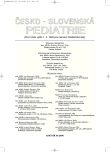What is New in the Diagnostics and Treatment of Arterial Hypertension in Children?
Co je nového v diagnostice a léčbě arteriální hypertenze u dětí?
Doporučení pro diagnostiku a léčbu hypertenze v dětském věku podle tzv. Čtvrté zprávy pracovní skupiny pro hypertenzi u dětí a adolescentů z roku 2004 přinášejí některé změny v této oblasti. V souladu s doporučeními pro dospělé je zaveden pojem prehypertenze, která je definována jako průměrný sTK nebo dTK rovný nebo vyšší než 90. percentil, ale nižší než 95. percentil, anebo TK ≥120/80 mm Hg nezávisle na výšce aktuálního 90. percentilu, ale menší než 95. percentil. V nových tabulkách percentilových hodnot TK je kromě 90. a 95. percentilu také uveden 50. a 99. percentil. V nových doporučeních se dále zavádí klasifikace závažnosti hypertenze na stupeň 1 a 2 v závislosti od toho, jak dalece hodnoty TK překračují 99. percentil. Od závažnosti hypertenze se odvíjí doporučení pro rozsah a urgenci vyšetřování a léčbu pacientů s hypertenzí. Vyšetření má být zaměřeno na vyloučení sekundární etiologie hypertenze, posouzení postižení cílových orgánů a odhalení ostatních kardiovaskulárních rizikových faktorů. Malé děti s 2. stupněm hypertenze mají být vyšetřeny podrobněji než pacienti s 1. stupněm hypertenze. Současné moderní technologie umožňují vyšetřovat méně invazivním způsobem než v minulosti. Léčba hypertenze spočívá v nefarmakologických opatřeních a v indikovaných případech v léčbě antihypertenzivy. Farmakologická léčba je indikována u symptomatické hypertenze, sekundární hypertenze, při prokázaném postižení cílových orgánů a u perzistující hypertenze, kterou se nepodařilo ovlivnit režimovými opatřeními. Terapeutickým cílem je dosažení hodnot TK pod 95. percentilem a u pacientů s chronickým renálním onemocněním, diabetem a známkami postižení cílových orgánů hodnot TK pod 90. percentilem pro pohlaví, věk a výšku.
Klíčová slova:
hypertenze, prehypertenze, měření krevního tlaku, klasifikace hypertenze, ambulantní monitorování krevního tlaku, diagnostika hypertenze, léčba hypertenze
Authors:
Š. Rucki
Authors‘ workplace:
Dětské oddělení Nemocnice Třinec
primář MUDr. Š. Rucki, CSc.
Published in:
Čes-slov Pediat 2006; 61 (9): 530-540.
Category:
Comprehensive Report
Overview
The recommendation for diagnostics and therapy of hypertension at the child age according to so called Fourth Report of the Working Group on High Blood Pressure in Children and Adolescents from 2004 bring certain changes in this area. In accord with the recommendations for adults a term prehypertension was introduced and defined as the mean systolic blood pressure or diastolic blood pressure equal to or higher than 90th percentile but lower than 95th percentile, or BP ≥120/80 mm Hg independently of the value of the relevant 90th percentil, but lower than 95th percentile. In the new tables of percentile values of BP, in addition to 90th and 95th percentile the 50th and 99th percentiles are also listed. The new recommendations also introduce classification of the severity of hypertension of the degree 1 and 2 in relation to that fact how far the BP values exceed the 99th percentile. The recommendations for the extent and urgency of examination and therapy of patients with hypertension then depend on the severity of hypertension. The examination should be aimed at exclusion of secondary etiology of hypertension, evaluation of the target organ damage and to uncover other cardiovascular risk factors. Small children with 2nd degree of hypertension should be examined in more detail than patients with 1st degree of hypertension. Present modern technologies make it possible to examine by less invasive way than those in the past. The treatment of hypertension is based on non-pharmacological measures and in indicated cases also by antihypertensive drugs. The pharmacological therapy is indicated in a symptomatic hypertension, secondary hypertension, in demonstrated target organ damage and in persisting hypertension, which could not be influenced by lifestyle changes. The therapeutic goal is to reach values of BP below 95th percentile and in patients with a chronic renal disease, diabetes and the signs of affected target organs the BP values below 90th percentile for sex, age and height.
Key words:
hypertension, prehypertension, blood pressure measurement, classification of hypertension, ambulatory blood pressure monitoring, diagnostics of hypertension, therapy of hypertension
Labels
Neonatology Paediatrics General practitioner for children and adolescentsArticle was published in
Czech-Slovak Pediatrics

2006 Issue 9
- What Effect Can Be Expected from Limosilactobacillus reuteri in Mucositis and Peri-Implantitis?
- The Importance of Limosilactobacillus reuteri in Administration to Diabetics with Gingivitis
Most read in this issue
- Primary Disorders of Lipid Metabolism in Children – Our Experience
- Does Artificial Suckling Nutrition Pose a Risk of Atherosclerosis at the Adult Age?
- National Cholesterol Program in Children’s Population in Slovakia and Its Contribution
- Food Supplements with Fish Oils – The Composition of Fatty Acids
